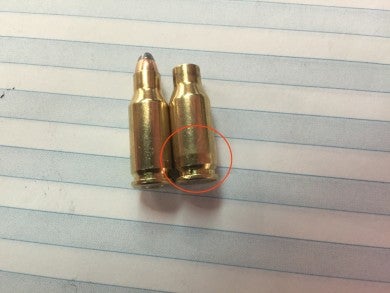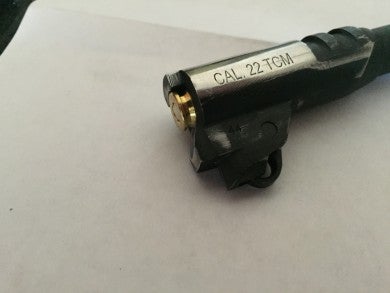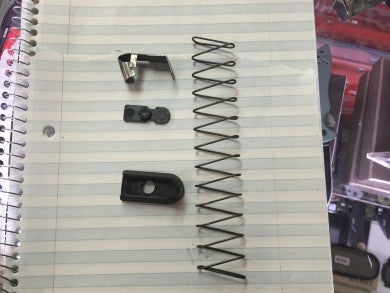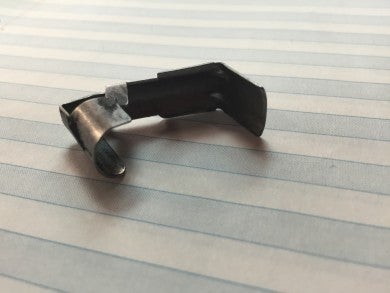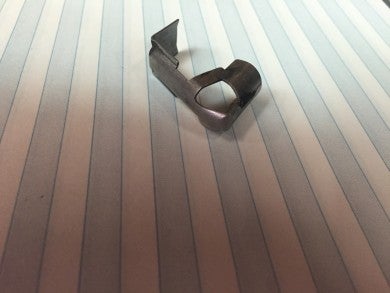My very first pistol was a 1911 Colt Commander. At the time I really had no clue as to what I had bought, or really anything about the platform. I had it until someone talked me into trading it for a Beretta 92FS, which to this day I still regret (though that decision eventually led me to my beloved Glock 17).
Just prior to doing my time at the bi-directional shooting range (and being forced to use the M92), I bought a Kimber Warrior. Which was yet another 1911 I really loved (with the sole exception of it’s ambidextrous safety).
Fast forward to about a month ago. I found out I was being sent a Rock Island Armory 1911 in .22 TCM. My first thought was, “Huh?!? Why on earth would you have a 1911 in anything but .45 ACP?”. We can record this as one of my first instances of being a crotchety old-man throwing out a “back in my day” quip. But I looked past my prejudice and did a little bit of research. (And yes, I do know that gunsmiths have chambered the 1911 to fire everything from .22LR to .30 carbine).
.22 TCM (Tuason Craig Micromagnum; Tuason is the president of Armscor, Craig is the gunsmith) is a proprietary cartridge developed by Fred Craig and Rock Island Armory. It was originally called the .22 Micro-Mag. It is a bottlenecked cartridge that is similar to the FN 5.7×28 in terms of performance. It is normally configured as a 40-grain jacketed hollow-point. The shoulder of the case is the same as a 9x19mm cartridge. As far as I can tell, the only manufacturer is Rock Island Armory and they also produce a bolt action rifle (in addition to the 1911 platform). Armscor (which is the parent company of Rock Island Armory) is the only commercial manufacturer of the .22 TCM round. It really looks a lot like a stubby .223 Rem round, which it was, in fact, based on (it is not truly a necked down 9mm).
Anyway, my FFL called as the Rock Island had arrived. I went down to pick it up and we all ogled at it. Definitely an oddity. It came in a pretty standard plastic box, but with a hard foam insert. The box included the usual paperwork stuff (instructions, warnings, etc), test rounds, a DVD (which I never opened), the pistol itself, two magazines and an alternate barrel and heavy spring (for the 9mm).
My first roadblock was trying to find .22 TCM ammo anywhere local to me. I had no desire to buy bulk online, nor really pay the shipping cost on a single box. Fortunately we had a gun show the weekend I received the gun, and I was able to pick up a box of Armscor (obviously the recommended brand, not reloads) from a dealer. And that dealer incidentally “every day carries” the exact pistol I was going to test and evaluate. After talking to him, and hearing the lavish praises he heaped on the platform, I was excited to shoot it.
I had a 3-Gun match that next day, and I figured that would be a great place to run it (in it’s .22 TCM configuration). I had run into one of the 3-Gun organizers (John) at the gun show and had asked if they set the course to run a single stack pistol as I was going to be running limited capacity (a buddy of mine actually had a 1911 in 9mm and was going to lend me a couple of magazines). John agreed and I figured I was set.
Observations
The first thing I noticed, after re-unboxing it at home, is that it was EXCEPTIONALLY smooth; racking the slide was butter smooth. It fit my hand perfectly, and the weight was balanced. The grips had a nice feel, not too rough but with enough texture to give a positive purchase. It had a nice wide, extended beaver tail. The sights were bright and clear. It was definitely a nice looking pistol and it felt great–I could see what the ammo vendor was raving about. The real test, however, would be on the range.
I did some dry fire practice with it in preparation for the 3-Gun match the next day, working the mechanics so I would be familiar with it (after all, a 1911 is not a Glock). I read through the instruction manual to make sure I was familiar with the operation and any peculiarities (there were none). It was already well lubed (and smooth feeling) so I didn’t add anything there.
Finally time to run it. I stepped up to the line after staging the weapons (order of shoot was going to be rifle, pistol, then shotgun). I ran the rifle, hit my targets, got up to the box to retrieve the Rock Island, picked it up and flawlessly seated a magazine. Racked the slide. Everything felt good so far. Pulled the trigger. Bang! Pull the trigger for my followup shot on the first target (since we typically hammer pair the targets). Nothing. WTH. Go into a failure drill. Have to actually rip the magazine out of the magazine well as it won’t drop free, and one of the precious .22 TCM rounds clatters out of the gun. I cannot rack the slide back. Can’t do it. Sigh. I tell the range officer that I’ve had a malfunction and am going to ground the pistol and move to the shotgun. I complete the shotgun stage (only missing one launched clay since I was still a bit flustered from the pistol stage with my nine “failure to engage the target” penalties). We safe the range, and I go retrieve the 1911. We recovered the dropped round, and there was no brass from the spent round (as it had not ejected). After application of some muscle I was finally able to rack the slide and recover the casing.
I decided not to run the pistol anymore until we had a chance to look at it back at the shop (with Luke from BMC). If there was a problem with it, I didn’t want to risk my safety.
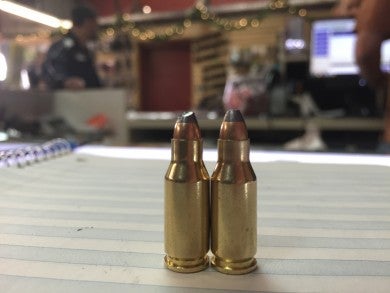
Note the mashed tip on the left. The round on the left was the round that attempted to feed after the malfunction.
Okay, so logically what would cause the behavior I experienced. Not being able to rack the slide. Hrrrmmm. That indicates that something was causing it to seize internally. That is a very short list of issues. I had dropped the magazine so that could not be it. That really leaves only one obvious choice; it meant that the extractor had hold of the casing but could not pull the round back. Immediately after firing, the brass would be hot, and thus expanded, which explains why a few minutes later I was able to eject the casing (after it had cooled and contracted). Sure enough. If you look at the picture of the brass side by side, you can see the spent round has some deformation near the base. I tried dropping the case into the breach. Yep that was it–the round never fully seated.
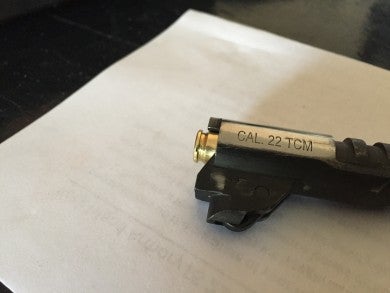
This is the fired round that expanded outside of the breach, and pretty close to the position it must have fired from. Note how far outside of battery it is.
That is a huge problem in my book. That means that the gun can fire with a round out of battery. I don’t know if it was a problem with this specific gun or this platform (I’d assume it was this one specific pistol). Okay so what caused this? We have to work backwards. Did I have a bad batch of ammo? I took every remaining round in the box and manually dropped them into the breach. All seated perfectly fine.
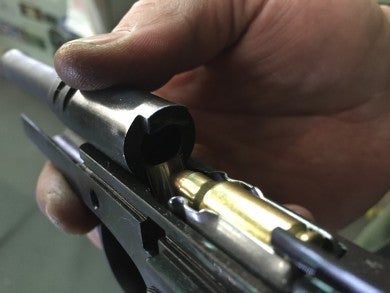
Slide removed to visualize how the round feeds. We didn’t have a gauge (or know the specs) to see if the spacing was off.
Is there a problem with the magazine? Manually trying to push rounds out of the magazine I noticed that the nose of the .22 TCM round dipped and would catch on the lip of the magazine–they were tilting slightly. I repeated the test with 9mm rounds and did not have the same problem.
Was that the cause? I’d assume not, since that would mean it would never feed, but it was definitely suspect. Break down the magazine. Looks pretty standard, the follower being a little rounded (for the .22 TCM I assumed). Next we checked the extractor. It was a little worn and did not really hold a round all that tight.
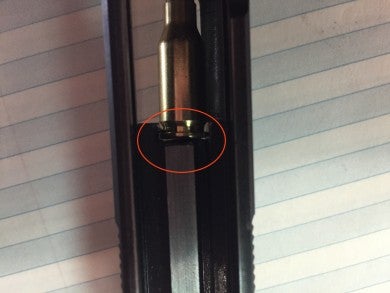
In the red circle you can see the gap between the face and casing. It was a lot more defined in person–the iPhone is not the best camera… 🙂
But it DID hold strong enough to not allow the slide to cycle. We could not remove the extractor to see if it was problematic (and I didn’t really want to force it). The gun was cleaned and I swapped out the barrel to see if it ran in the 9mm configuration.
I took it out and ran through a full magazine with no problems. Okay, so it was definitely just a problem with the .22 TCM system, and so far, only the first time. I swapped back to the .22 TCM barrel and spring. And the same thing happened as the first with the exception that the slide actually cycled back, but failed to extract the round. You can see the video below.
Just for giggles I figured I’d try the “9mm” spring. Which in retrospect, from a safety standpoint, was probably not the smartest idea since I had already experienced two failures of high pressure rounds going into battery. Certainly a “heavier” spring would be worse for the action to overcome. But to my surprise, I was able to fire through the rest of the magazine. Logically, that would indicate that the springs were initially switched. The spring that was pre-installed when I received it would have been the 9mm spring with the .22 TCM barrel.
The lighter spring should be the one with thinner gauge wire and/or fewer coils. Which highlights what I think is a safety issue. How do you “know” which spring is the right one? They are not labeled, nor does the instruction manual (or documentation) differentiate aside from “lighter”. I am going to assume that the failure was related to me not confirming the springs. But even now, looking at the springs, what I think is the “lighter” one is actually the longer spring (it just feels less substantial). Both springs weigh exactly the same. It is a clear problem that the round did not go into battery, but the cause? I’m still not entirely sure. I did find a thread on the 1911 Forum that discussed an issue in 2012, but it seems if that was related to a wrong extractor (my T&E gun did not come with an alternate extractor).
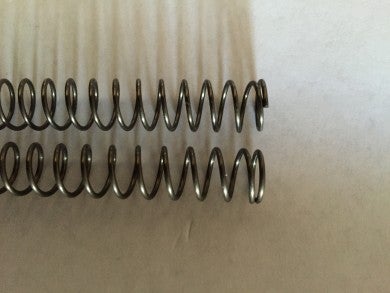
On first glance, you would think the lower spring is the “heavier” one, but that is not the case. At least from my testing, the lower spring is the one that the .22 TCM fired and cycled with. The 9mm fired and cycled with both springs.
Conclusion
Overall I think the concept is interesting, though I still think the 1911 platform should just be .45 ACP… 🙂 A couple of people that I’ve talked to (that carry it) really like the .22 TCM. The actual weapon that I was sent seemed to have been well used (which is not generally a problem), but I had a negative first experience with it (was it worn out?). Once I sorted out the spring issues (I think), it seemed to run fine. I think Rock Island needs to paint the springs (or otherwise mark them). It is a huge problem that the wrong spring can induce a failure to go into battery, and even more so that the weapon will fire in an out of battery state (which I cannot confirm for the entire line, just for the specific one I was sent, or if that is actually even the cause of the problems that I had).
A search on the web indicates that a number of these guns suffer from the same issues with “out of battery” or “failure to eject”. But, on the other hand, Rock Island also seems to have really great customer service (based on the feedback in the same articles that discuss the problems), and have been super proactive in fixing/replacing problematic components. I personally did not call RIA up and discuss the problems with the one I had.
I think that if you are interested in this platform, and are willing to take the risk with some potential quality control issues (which, again, it sounds like Rock Island is addressing) give it a try. The versatility of being able to shoot 9mm or, in essence, a shortened .223 Rem round is cool. Just make sure you pay close attention to how it behaves and be ready to address any problems.
Technical Specs:
Model Number: 51961 – TCM 2011A1 FS
Action Type: Semi-automatic
Barrel Length: 5 inch
Caliber: .22 TCM/9mm
Capacity: 10 rounds
Length: 8.75 inch
Height: 5.5 inch
Width: 1 13/32 inch
Weight: 2.25 lbs
Sights: Front Orange Fiber-Optic, Rear White-dot (Elevation & Windage adjustable)
Price: MSRP ~$749
 Your Privacy Choices
Your Privacy Choices

